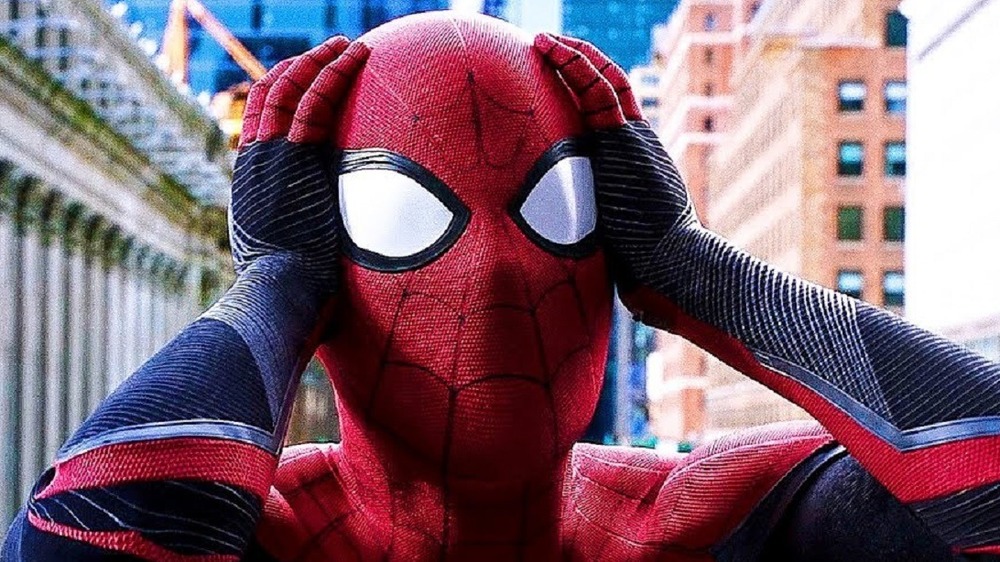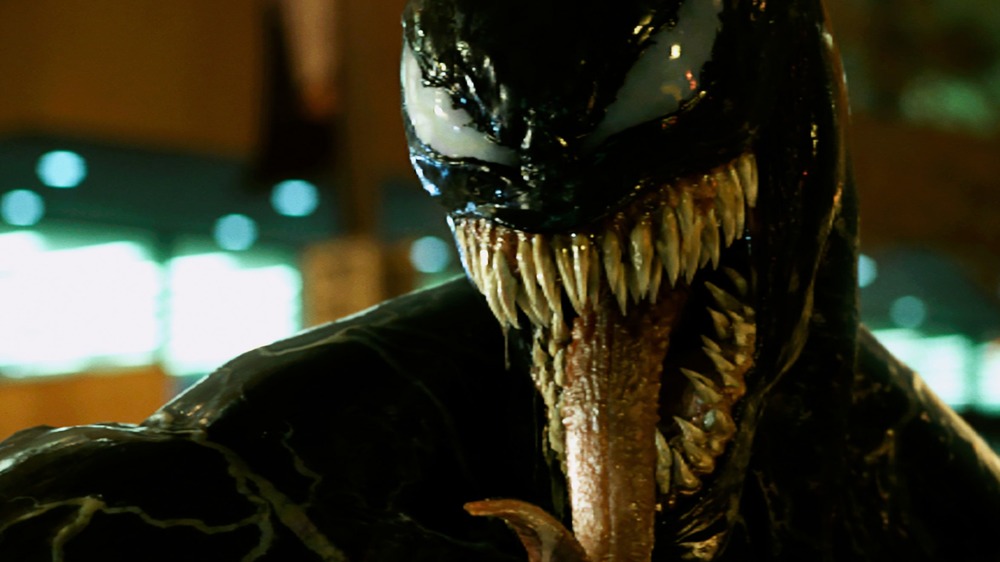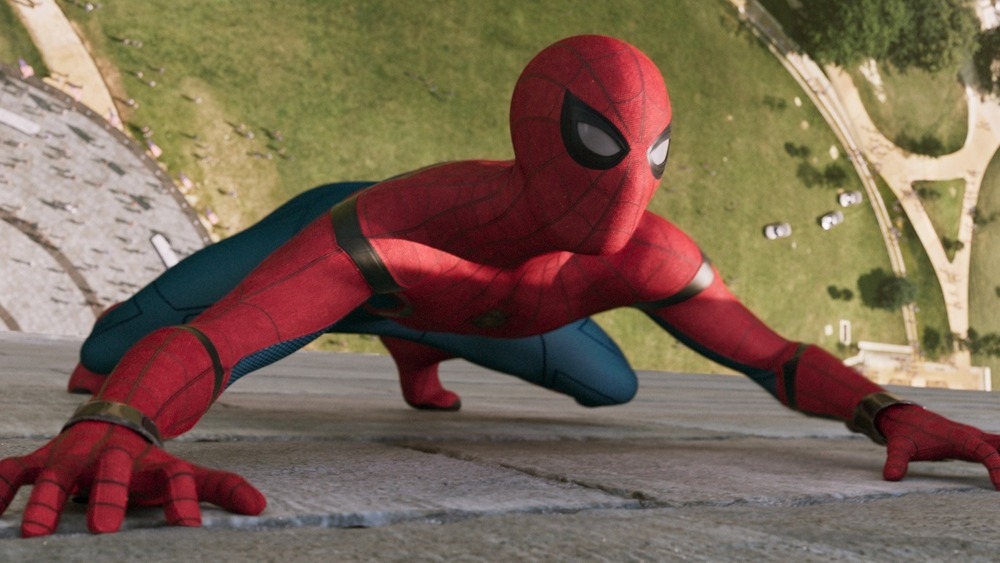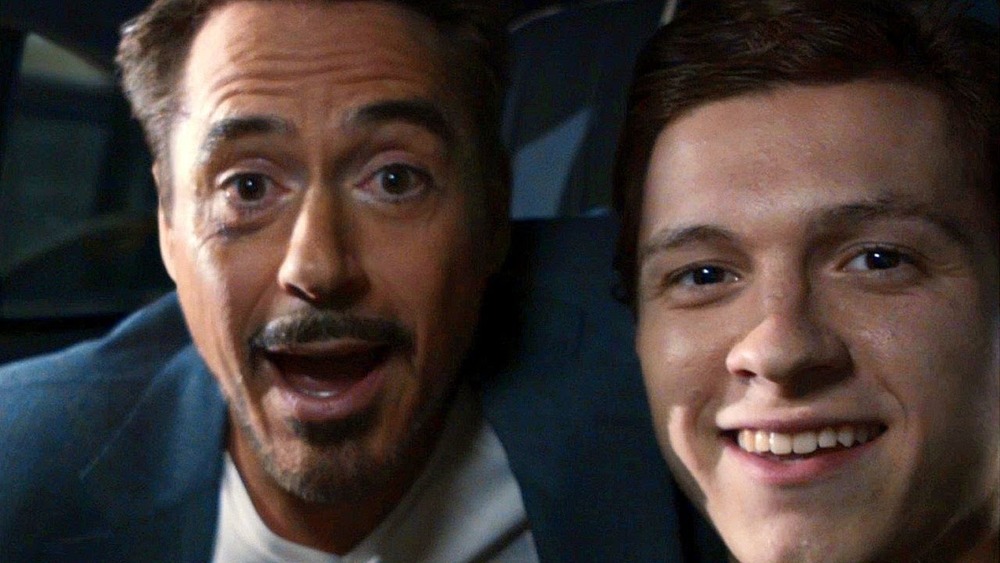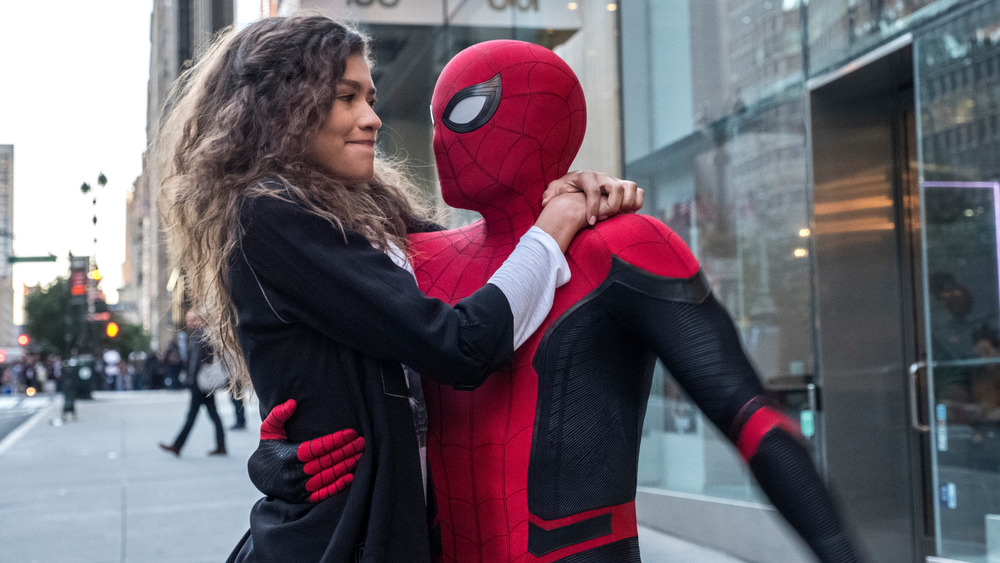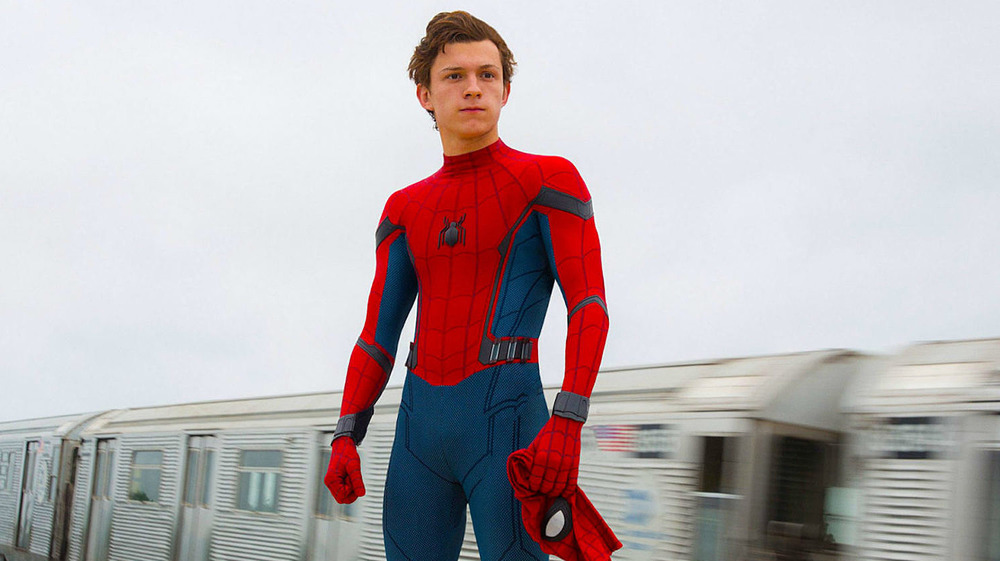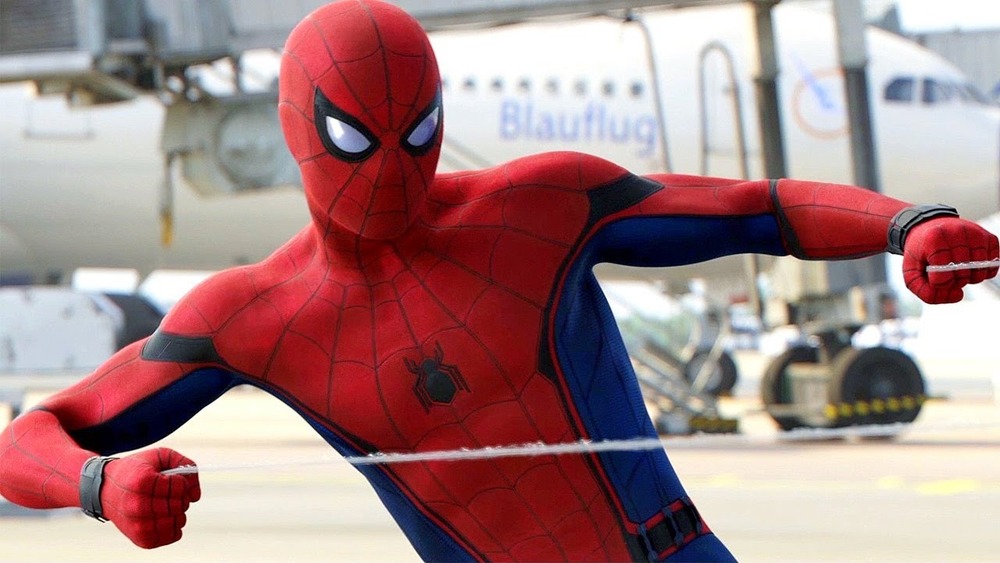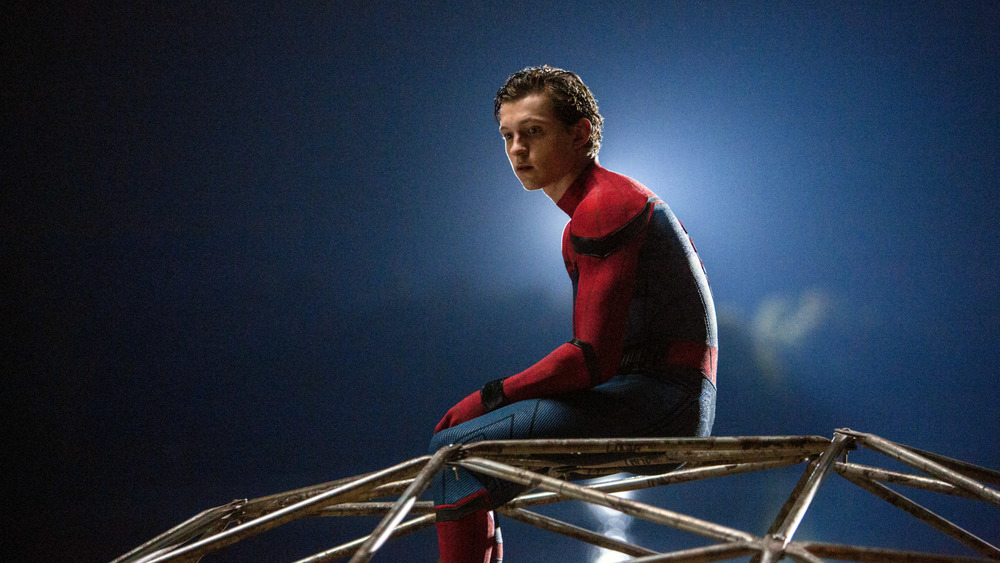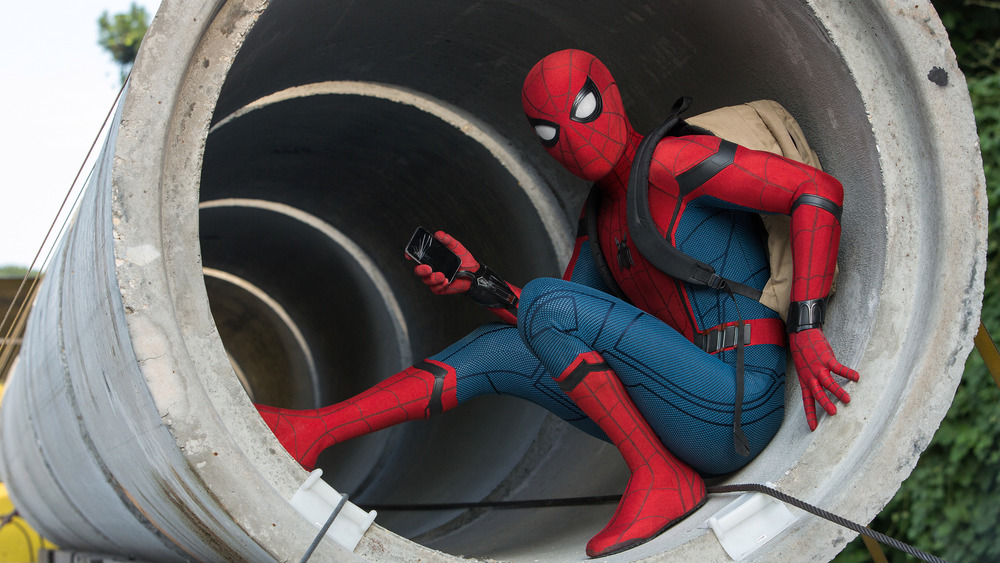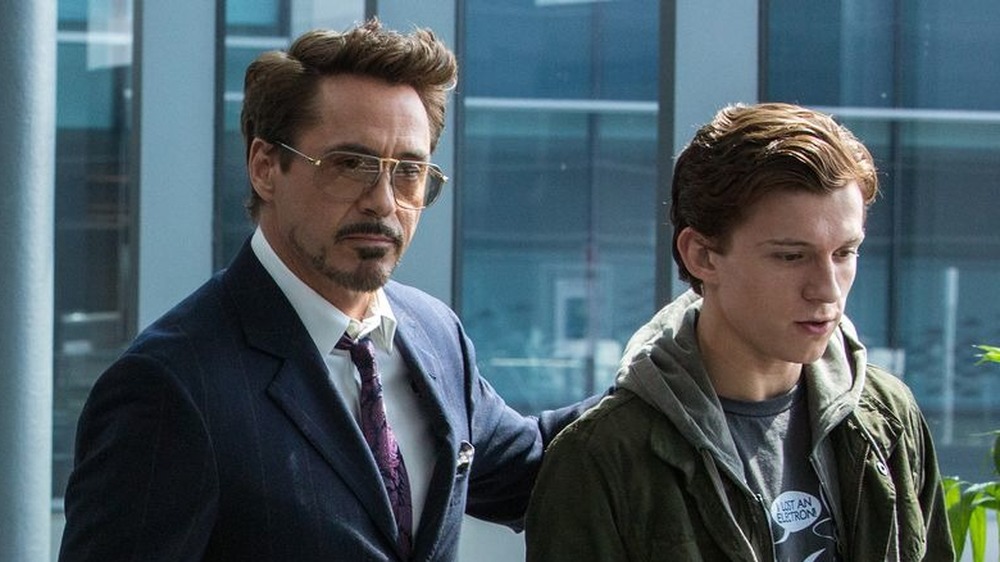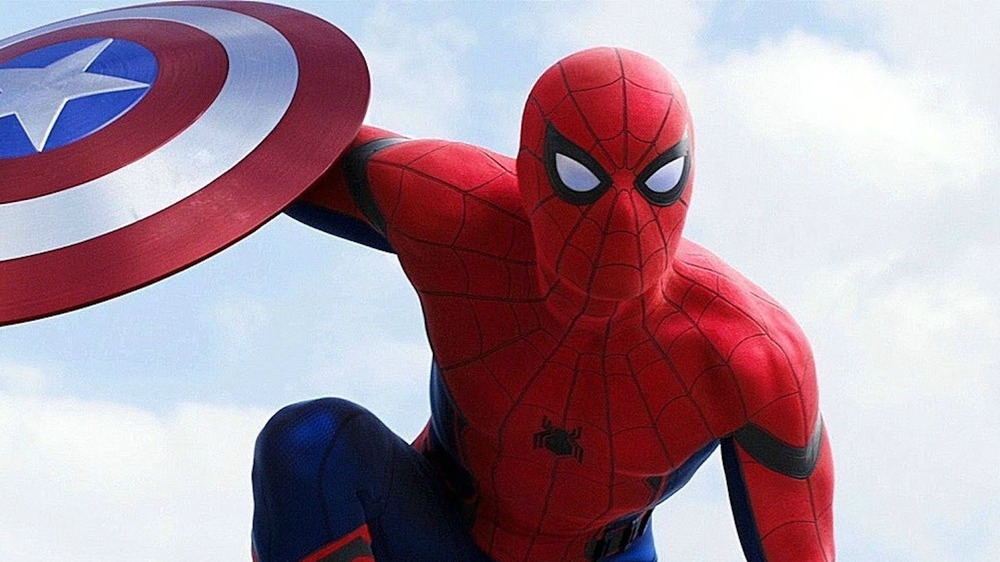Rules Spider-Man Has To Follow In The MCU
Spider-Man has appeared in a wide variety of live-action movies over the years, and while we all love the Sam Raimi films, the wall-crawler really found his home in the Marvel Cinematic Universe. Since joining the MCU, Peter Parker (Tom Holland) has battled Vulture in New York, faced Mysterio in Europe, and magic-kicked Thanos in outer space. But while the character sometimes ignores the wisdom of his mentor Tony Stark, it turns out that Spider-Man actually has to follow some pretty strict rules.
As comic book fans know, Spider-Man is only in the MCU thanks to a unique deal between Marvel/Disney and Sony Pictures. It allows Sony to hold onto the film rights to this iconic character while letting Marvel Studios be the primary creative driving force between Peter Parker's movies. This partnership has yielded some acclaimed solo films and some exceptional team-up movies. But these accomplishments would never have happened without a strict set of parameters. And what are these codes keeping Spidey in check? Well, read on for the rules Spider-Man has to follow in the MCU.
Spider-Man has to be able to interact with Sony Pictures properties
For the longest time, it was uncertain if the MCU version of Spider-Man could interact with other Sony Pictures adaptations of Marvel properties. Spider-Man producers Kevin Feige and Amy Pascal gave contradictory statements about the matter during the summer of 2017 while promoting Spider-Man: Homecoming, with Feige maintaining that there were no plans for such a crossover while Pascal explicitly said that films like Venom would be "adjacent" to the new MCU Spider-Man titles. The back-and-forth on this matter got so out of control that reports surfaced indicating that Tom Holland filmed a cameo as Peter Parker for Venom, only for Marvel Studios to ask Sony to cut the appearance.
When Sony and Marvel re-upped their agreement to work together on Spider-Man movies in September 2019, though, clarity finally emerged. In the announcement of this decision, Feige himself mentioned that Spider-Man "also happens to be the only hero with the superpower to cross cinematic universes, so as Sony continues to develop their own Spidey-verse, you never know what surprises the future might hold." With this decision solidified, the doors opened up for Sony to utilize the MCU version of Spider-Man across their own separate cinematic universe. Given that, don't be surprised if Tom Holland's take on Spider-Man makes a physical appearance in upcoming Sony/Marvel movies.
Each Spider-Man film chronicles a school year
Superhero movie franchises have typically followed the mold of trilogies. Three solo outings and that's it until someone new takes on the character. This was true for heroes like Iron Man, Captain America, and Christian Bale's version of Batman, for example. The MCU version of Spider-Man, meanwhile, isn't adhering to those same rules, despite the fact that Tobey Maguire's version of Spider-Man capped off his trilogy with just three movies. Instead, the MCU version of Spider-Man is taking cues regarding its amount of solo movies from a fantasy cinema icon.
In an early interview about these MCU Spider-Man movies, Kevin Feige revealed that the Harry Potter franchise had an impact on individual Spider-Man movies reflecting individual years of Peter Parker's high school experience. Explaining the reason for this, Feige said (via Collider) that the people behind these movies thought, "How do we do a journey for Peter not dissimilar for what the students of Hogwarts would go through each of their years, which was one of the early ideas we had for the movies." Through this method, the fact that Peter Parker is the rare superhero to also be a high schooler gets extra-reinforced.
Given this approach and that American high schools traditionally have four years, it shouldn't be a surprise that the MCU Spider-Man is looking to go beyond a trilogy. A fourth solo MCU Spider-Man movie is in the works, but they better hurry before Tom Holland really starts showing his age.
He can interact with other Marvel superheroes
In the comics, where no complicated film rights can get in the way, Spider-Man has always interacted with other superheroes. One of his first solo adventures even saw the web-crawler trying to join the Fantastic Four, only to leave once he realized the team didn't pay its members.
Previously, legal complications prevented the live-action version of Spider-Man from rubbing shoulders with other Marvel superheroes. In the modern world, though, Sony's Spider-Man movies don't just feature Spider-Man. They're also capable of featuring other Marvel superheroes like Iron Man and Nick Fury. In 2017, The Hollywood Reporter revealed that part of the Sony/Marvel deal allowed Sony to utilize one major Marvel character they didn't have the films rights to. So for Spider-Man 3, that role would be fulfilled by Benedict Cumberbatch's Doctor Strange.
On one level, this gesture allows Spider-Man to reaffirm his placement in the MCU even when he's not in a Disney-financed movie. Rather than feel like stories adjacent to the larger MCU, the presence of Nick Fury, for example, firmly places Spider-Man as part of a much larger universe. Of course, it's also helpful for Sony that they can plaster famous faces like Iron Man on the posters of their summer blockbusters. The advantages to this trait have been numerous, hence why Spider-Man is allowed to take a cue from his comic book counterpart and interact with other Marvel superheroes.
The rule about Marvel TV shows
For the first time in his history of live-action movies, the MCU Spider-Man is able to freely interact with other members of the Marvel universe. However, this luxury only extends to other Marvel movie properties. When it comes to Spider-Man crossing paths with Marvel television characters, that's still off-limits. It was revealed in 2014 that Sony still has first dibs on live-action TV shows starring Spider-Man, while Kevin Feige would later clarify that the Sony/Marvel contract only allowed for Spider-Man to appear in MCU movie properties.
This aspect of the Sony/Marvel deal explains a number of strange details about Marvel's TV programs. For instance, it explains why the Marvel's Netflix shows name-dropped the likes of Captain America or Tony Stark but never mentioned that famous web-crawler, despite Daredevil and Spidey both residing in New York City. This complication endures even past the age of The Defenders. Despite Marvel Studios putting countless TV shows into development for Disney+, none of these announced shows involve elements from Spider-Man's mythology. Additionally, supporting characters from his movies haven't been announced to be in the cast of any of these programs.
Meanwhile, Sony Pictures Television has announced plans to start their own universe of TV shows based on Marvel Comics characters that they own, starting with Silk. All this means that, while Spider-Man may be able to freely move across various Marvel properties on the big screen, it's a different story on the small screen.
No origin story, no problem
For Sony's first two attempts at making Spider-Man movies, the character's origin story was constantly present. Both Tobey Maguire and Andrew Garfield's time in the red-and-white suit began with the story of a plucky high school nerd who gets bitten by a spider, watches his Uncle Ben die, and then must learn that "with great power comes great responsibility." Considering that The Amazing Spider-Man got widely criticized for retreading familiar ground vis-a-vis that origin story, it's no surprise that the MCU Spider-Man opted to go in a different direction.
For this newest incarnation of the character, Spider-Man is introduced in Captain America: Civil War having already got his powers a few months back. From there, the various Spider-Man movies have been constantly moving forward into the future, without any flashbacks to Parker's time getting his superpowers. Instead of having Spider-Man's first solo outing, Homecoming, be preoccupied with rehashing his origin story, the film gets right down to showing what a day in the life of this friendly neighborhood superhero is like.
While the MCU Spider-Man hasn't been preoccupied with his origins, that isn't to say that hints to his iconic backstory haven't appeared throughout the movies, such as in Parker's "when bad things happen" monologue in Civil War or Uncle Ben's initials appearing on a suitcase in Spider-Man: Far From Home. But for the most part, the MCU Spider-Man has had no need to rehash an origin story audiences are already familiar with.
MCU Spider-Man uses mechanical, not organic, web-shooters
When Peter Parker first made his way into 21st-century feature films with 2002's Spider-Man, the character came to the screen primarily resembling how fans remembered him from the comics. However, there were a few differences, with one particular deviation from the comics being especially peculiar. Spidey now produced his web organically through his arms rather than through home-made mechanical web-shooters. Per Spider-Man screenwriter David Koepp, this was a relic from an earlier draft of Spider-Man penned by James Cameron. Why the director of Avatar decided to give Spider-Man this feature remains a mystery.
When it came time for Sony's first Spider-Man reboot with The Amazing Spider-Man, one way the film chose to differentiate itself from its predecessors was by giving Peter Parker back his mechanical web-shooters. For the MCU take on Spider-Man, Peter Parker once again produces his webbing through a device of his own creation. It's a feature that does far more than just align the character with his comic book counterpart. In the context of his first appearance in Captain America: Civil War, it reinforces that this teenager has enough intellect to get onto the radar of someone like Tony Stark. In later films, it's also a symbol that Parker doesn't need to rely on Stark Industries technology to come up with impressive and helpful knick-knacks. Basically, giving Spider-Man his classic web-shooters has ended up being a boon both for comics accuracy and the individual MCU Spider-Man movies themselves.
There are rules about Spider-Man using drugs
One of the many documents leaked to the public through the December 2014 hack of Sony Pictures Entertainment included a series of guidelines that any film portrayal of Peter Parker had to follow. Dictated by Marvel to Sony, these offered a glimpse into the kind of strict parameters that major feature films have to work around when adapting iconic characters like Spider-Man. The restrictions, which include insistences like Spider-Man never using harsh profanity, appear to mostly function as a way of making sure Peter Parker only stars in PG-13 films, thus preserving the character's family-friendly image.
Among the most puzzling of these guidelines was a mandate that Spider-Man can never be depicted doing drugs. Specifically, Spidey "does not smoke tobacco; does not sell/distribute illegal drugs." Characters like Iron Man have tackled heavy topics adjacent to drug use like alcoholism in the comics before, so it's not unfathomable that a Marvel Comics character could engage in this conversation. However, Spider-Man in the comics, save for the trailblazing comics storyline Green Goblin Reborn!, has never touched the topic of drug use, let alone explicitly depicted Peter Parker using or selling illicit substances.
Given the lack of source material to adapt and the fact that Sony had always intended to make PG-13 family-friendly movies based on Spider-Man, it's doubtful any screenwriters were going to suggest a version of Pineapple Express starring Spider-Man. Still, Marvel's guidelines have ensured that one thing Spidey will never do onscreen is drugs.
Splitting Spider-Man's box office profits
Initially, it appeared that one rule for Spider-Man being in the MCU was that Marvel Studios couldn't profit off the partnership. Shortly before the release of Spider-Man: Homecoming, it was revealed by The Wall Street Journal that "no money changed hands" through this Sony/Marvel Studios deal. The same report also stated that Sony would keep all the profits from Homecoming's worldwide box office release. This seemed like an easy way for Sony/Columbia to reaffirm that they still had a significant control over the Spider-Man property, even if Marvel Studios was driving many of the creative decisions.
However, this changed with the sequel to Spider-Man: Far from Home. The entire partnership between Marvel Studios and Sony Pictures briefly broke down over Marvel's parent company, Disney, wanting 50% of the box office of the next Spider-Man movie. Thanks to the clamor of both fans and Tom Holland himself, the deal managed to get mended but with a massive alteration in how the profits of Spider-Man movies will be split. Disney and Marvel Studios will now finance 25% of the next Spider-Man movie and receive 25% of the films profits. Thanks to this compromise, for the first time ever, a major American movie studio that isn't Sony/Columbia will be ponying up cash to finance a Spider-Man film. That isn't how the Sony/Marvel deal started out, of course, making this one of the more flexible rules for Spider-Man's appearances in the MCU.
His connections with Tony Stark
In the comics, Tony Stark and Peter Parker weren't especially close figures. They had their share of interactions, but prior to the MCU, it was doubtful many comic readers directly associated the two characters with each other. That all changed with Captain America: Civil War, which saw the MCU's then-biggest hero, Iron Man, recruiting Spider-Man for an important mission. Their bond was no one-off event, with Stark serving as a father figure to Parker in Spider-Man: Homecoming and Avengers: Infinity War. The relationship resulted in one of the most famously poignant moments of the latter movie, in which Parker is snapped out of existence and, as he perishes, clings to Stark while crying out about how he doesn't want to go.
Even if it didn't come from the comics, moments like those made the Stark/Parker dynamic one that audiences largely enjoyed. It's also a rapport that became so ingrained in the MCU Spider-Man mythology that, even after Stark's passing in Avengers: Endgame, his presence cast a long shadow over Far From Home, which saw Parker grappling with the death of Stark. Downey Jr.'s presence as Iron Man not only gave the first solo MCU Spider-Man movie some major star power, it helped to cement this version of Spider-Man as one explicitly different from prior incarnations of the character by giving him a mentor/apprentice relationship that prior movies lacked. It's also a good example of how, sometimes, deviating from the comics can result in some truly inspired storytelling.
Spider-Man can't redo plotlines of old movies
When the script for Homecoming was first coming together, the fact that there had already been five live-action Spider-Man movies since 2002 wasn't lost on the film's initial screenwriters, John Francis Daley and Johnathan Goldstein. "We knew that just because there are so many versions of this franchise that exist that ours had to be different and had to have a very distinct voice that set it apart from all the others," explained Daley (via Creative Screenwriting).
To accomplish this task, the writers set out to make sure this version of Peter Parker didn't just regurgitate plot details and set pieces from earlier Spider-Man films. For example, Daley mentioned that Homecoming's use of "environments for [Spider-Man] to be in where he isn't as able to use his powers" was derived from how earlier Spider-Man films used the character almost exclusively against large skyscrapers. Goldstein also recalled how the duo even went so far as to create "a laundry list of all the things that you've seen in the other five movies and tried to make sure we didn't do those again."
Even though Daley and Goldstein left the MCU after Homecoming, their approach has been carried over to further Spider-Man movies, which have seen the character go to locations like Prague and outer space, places that he didn't visit in earlier films. Through following this rule, the MCU Spider-Man has been able to establish his own identity.
